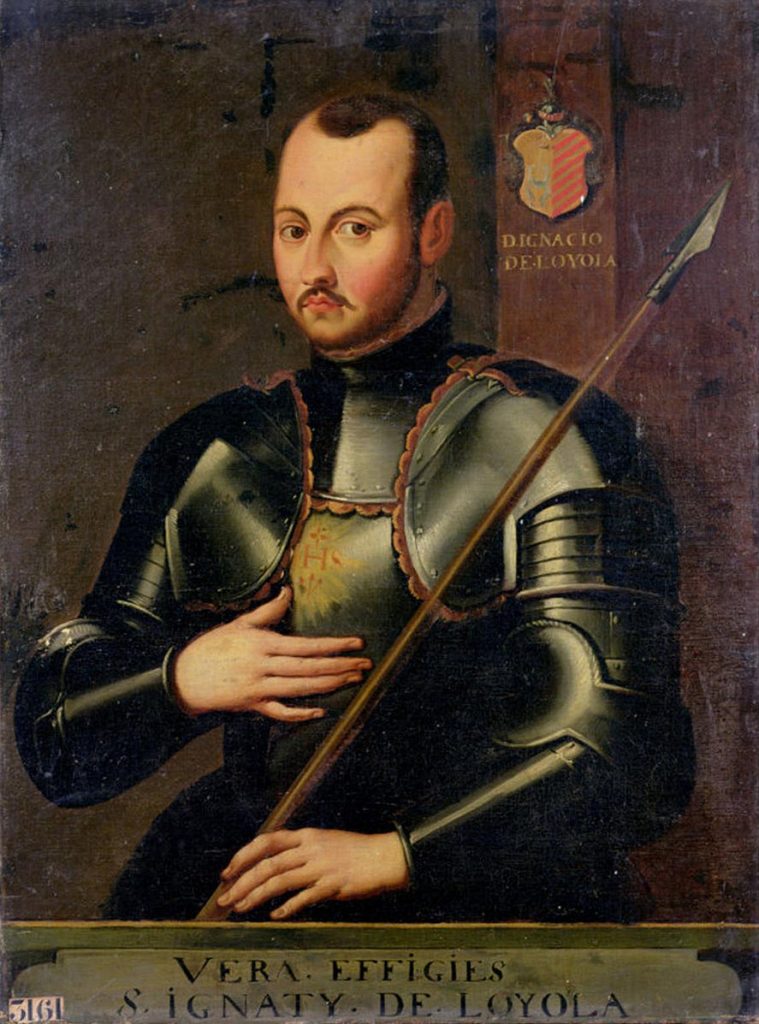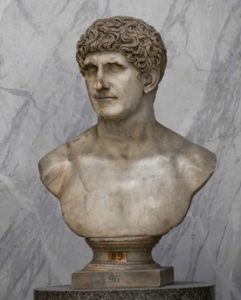St. Ignatius was a Spanish priest who founded the Society of Jesus, or Jesuit Order, in 1540. He intended the society to be servants of the pope, and therefore of the universal Catholic Church. The Jesuits have been given credit for responding to the Protestant Reformation and for winning back to the Catholic fold many of the people who had left the church.1 St. Ignatius, known as Inigo in Spanish, lived a life of chivalry in his early years. Before devoting his life to God, he was a dedicated solider, and it wasn’t until he came to a near death experience that he decided to change his life.
In 1521, Ignatius was a soldier fighting to defend the Spanish city of Pamplona alongside his master Antonio de Manrique, the Duke of Nájera, against the French. Negotiations began between the besieged Spanish and the French military leaders, and when talk of surrendering to the French came up, Ignatius was furious at the weakness of his Spanish negotiators. He wanted to defend the city or die trying.2 The French proceeded to attack the city. Unfortunately, Ignatius was shot by a cannon and was seriously injured. The cannonball had struck his legs and seriously damaged one of them. Fortunately, some French soldiers tended to his damaged leg. The soldiers saved his leg from amputation, so in return, Ignatius gave away his shield, corset, and dagger to the French soldiers. From the battlefield, Ignatius was transported to northern Spanish town of Anzuola to recover.

When Ignatius arrived in Anzuola, the doctors decided that it would take multiple surgeries to help him. First, they decided that his leg had to be broken again and his bones reset. During the first operation, Ignatius did not utter a single sound, and the only indication of pain he gave was clinched fist. The operation brought Ignatius to near death. He was advised to confess his sins to a priest, and was told that if he did not feel better, he could consider himself a dead man. That night Ignatius prayed to St. Peter and later that night he started to feel better. However, something went wrong during the second surgery. As the bones in his right leg settled, a piece of the bone had started to push itself forward from his knee creating a stub.3 Ignatius immediately demanded another operation be performed. Ignatius believed that life had no purpose if he could not prove his courage to women or wear the elegant knee-boots of the hidalgo.4 The doctors advised against this, but Ignatius insisted. Again, he did not utter a single sound during the very painful surgery. The surgery was a success, but Ignatius remained bedridden for months. When he was well enough to read, he requested books of chivalry, but there were no books of that kind in the castle. Instead, he was given The Life of Christ and The Lives of the Saints.
These two books had a great impact on his life. At first, Ignatius read these books in disgust. He dismissed the saints for the penances they performed. Slowly, the nobility of their actions grew on him. He was able to find things that he admired about them. One saint that caught Ignatius’s eye was Saint Francis. He admired St. Francis’ courage, his love of dancing, his singing, and his love for nature. These books changed the way he thought about life. He wanted to be a working servant of Christ, like St. Francis had been. While he was recovering, he saw a vision of Mary, the mother of God, and was filled with joy. This vision of Mary made Ignatius completely devote his life to God.
After he had recovered, he gave all his clothes away and became a hermit and focused on helping the sick. He wrote about his experiences, which eventually became known as the Spiritual Exercises. He knew he would need an education to help convert people, so he went to Barcelona to further his education. He became a priest in 1537. In his earlier life he had been a faithful and dedicated solider, and now he brought those same characteristics to his life in the priesthood. In 1540, Pope Paul III confirmed the formation of the Society of Jesus. Ignatius led the Jesuits along the lines of his military experience, but instead of fighting on military battlefields, they were to dedicate their military-like focus to serving the interests of God and to converting people back to the Roman church. When Ignatius died in 1556, there were one-thousand Jesuits working in Europe, Asia, and the Americas.5 The Jesuits have been known ever since for their strong belief in education and for their missionary work. Today, Jesuits can be found throughout the world, contributing to their missionary work and to their many schools.
- Salem Press Biographical Encyclopedia, 2005, s.v. “Saint Ignatius of Loyola,” by Carol S. Berg. ↵
- Hugo Rahner, St. Ignatius of Loyola: a pictorial biography (Chicago: H. Regency, 1995), 14. ↵
- Hugo Rahner, St. Ignatius of Loyola: a pictorial biography (Chicago: H. Regency, 1995), 14. ↵
- Philip Caraman, Ignatius Loyola: a biography of the founder of the Jesuits (San Francisco, California: Harper & Row, 1990), 26. ↵
- Salem Press Encyclopedia, 2015, s.v. “Society of Jesus (religious order),” by Rebecca Kraft Rector. ↵



46 comments
Carlos Aparicio
This is an amazing article of Saint Ignatius. I was very interested to read more about St. Ignatius when it described his life hood before his religious workings. Who knew that two books would inspire a saint of that time? It was very fortunate that St. Ignatius was saved and cured by the French, whom were the enemies of Pamplona. By reading this article, you can strongly tell how St. Ignatius was so passionate about the works of Christ. I love how this article was well put together.
Karina Nanez
Saint Ignatius of Loyola is one of my favorite saints because of all he went through in life just to discover God. I have always thought so hilarious that he was a vain man determined to be a chivalrous man and find a wife when getting his leg almost blown to bits by a cannonball completely changed his life. And even when he was bedridden with nothing to do but wait for his knee to heal he still wanted to fight and be a “chivalrous man.”
Andrew Rodriguez
His conversion of being a person of violence to a man of peace. Is really astounding, almost like the Malcom X story who found a religion or a different way of life. He was crazy tough, in taking three surgery’s without making a sound or moving. I had no idea of who this guy was, till I read this article he is a very interesting character in history. The article was very well written and researched. Shows that anyone can change who they are, there ideals and way of life.
Sergio Cervantes
I enjoyed reading this article Mario! It was nice to read about the life of such an important saint for the Catholic faith. I did not know St. Ignatius was struck by a cannonball that shattered both of his legs; how painful it must have been. I find it interesting that the soldiers who gave him aid were the very ones whom he sought to destroy. It is ironic in a sense but nonetheless important for this man’s conversion. Without a doubt, the life of this man has had a profound effect on the whole world including the lives of the society’s members.
Faisal Alqarni
Hello Mario, I have always known of the Jesuits as a band of brothers dedicated to some hermit like life, I never did know that Ignatius was the first to practice their ways. This kind of selflessness and belief only shows that every one of us can dedicate our various god given talents to good even if not in entirety but in everything we do.
Bailey Rider
Great article Mario! It was really well written and interesting to read! It was cool to learn about St. Ignatius and how he eventually commuted to the church. It’s crazy all of the things he went through! With all of the pain he went through, he must have been so strong! You’re article seems well reasearched and was fantastic! Great job!
Luke Trevino
Overall very good article! I grew up Christian and therefore do not know much of the Catholic traditions. I know very little of the Saints, but I am very inspired and happy I’ve read of this man. He is a good role model for all believers. All the pain he went through was because he remained faithful to his beliefs. Overall very good essay it was so imformative very good read!
Mariana Govea
Good article! very well written and researched! I found your article pretty interesting since actually back home I attend the church of St.Ignatius,however I never really knew his story!! But now after reading your article i know the big impact he made on history as well as how strong and dedicated he was! After being put trough those tests he could have easily given upon and even loose his faith but no he took all of his pain and anger and turned it into something wonderful which is something great that not anyone is able to do therefore that is why he is admired by many today!
Erick Martinez
This is a very well written article, I had never heard of St. Ignatius and his journey to priesthood. As a catholic I take great joy in hearing others life changing experiences. As Ignatius entered his third and final surgery he had no idea his life would take such a drastic turn. It is amazing to see how two books could take a knight and turn him into a follower of Christ.
Alyssa Valdez
Very interesting Article! I have never heard about St. Ignatius so I thought your article was very informative and such an interesting read. I also thought that the photo’s you decided to use were very captivating and such a nice addition to your article. I can tell the St. Ignatius was very passionate about his faith who was also dedicated to protecting lives